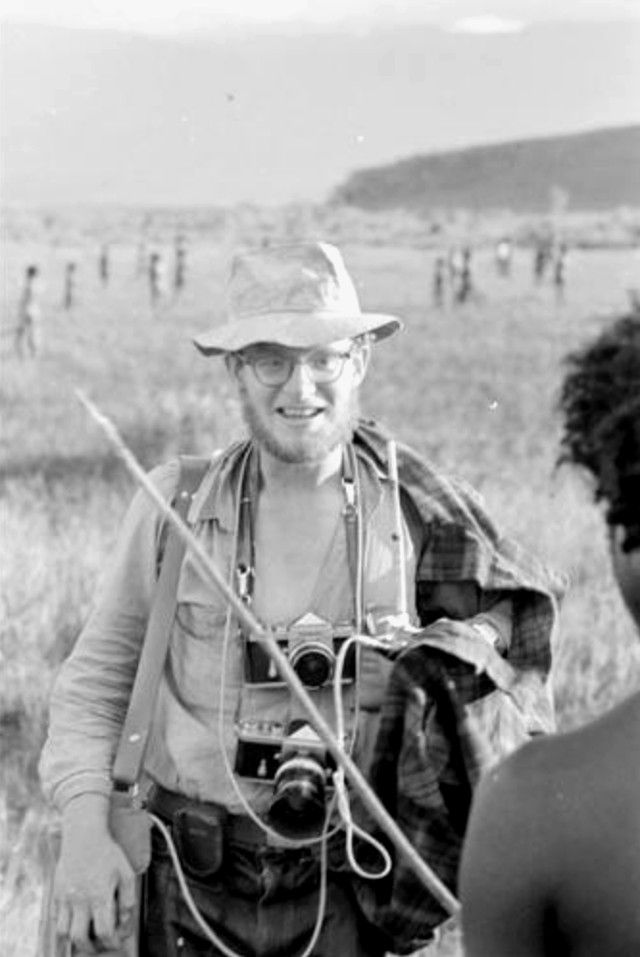The Disappearance of Michael Rockefeller: Mystery, Art, and the Edge of the World
- Daniel Holland

- Sep 27
- 7 min read

On a clear November morning in 1961, a young man from one of America’s most powerful families made a decision that would echo across decades. “I think I can make it,” Michael Rockefeller told his companion, before slipping into the rolling waters off the coast of New Guinea, clutching two empty fuel cans for flotation. Those were the last words ever heard from him.
What followed was a mystery that refused to fade. Was Michael dragged under by currents and drowned? Or did he, against all odds, reach shore, only to be caught up in the violent cycles of revenge among the Asmat people — where headhunting and ritual cannibalism were still very real? His body was never recovered. His name became legend. And more than sixty years later, the story remains one of the most haunting disappearances of the twentieth century.

Michael Rockefeller: A Short Biography
Michael Clark Rockefeller was born on 18 May 1938, the fifth child of Nelson Rockefeller — future Governor of New York and later Vice President of the United States — and Mary Todhunter Clark. He was a grandson of John D. Rockefeller Jr., and thus part of a dynasty that symbolised wealth, influence, and philanthropy in America.
Unlike some of his siblings, Michael was drawn not to politics or business, but to culture and anthropology. After graduating from Harvard in 1960, he worked with his father’s Museum of Primitive Art in New York, where he developed a fascination with the Asmat people of New Guinea. Their elaborate wood carvings and ritual objects had already caught the attention of collectors in the West. Michael was determined to travel, meet the artists themselves, and bring pieces back for study.
In 1961, he joined an expedition led by Dutch anthropologist René Wassing into one of the most remote and little-understood regions on Earth. It was a decision that would define (and end) his life.

The Canoe Accident
On 17 November 1961, Rockefeller and Wassing were travelling in a 40-foot dugout canoe, accompanied by two local guides, Simon and Leo. They were about three nautical miles (roughly six kilometres) from shore when disaster struck. Their double-pontoon boat was swamped by waves and overturned.
The four men clung to the wreckage as they drifted. After a time, Simon and Leo swam for help, leaving Michael and Wassing adrift. Hours stretched into days. By 19 November, with rescue still nowhere in sight, Michael made his fateful decision.

According to Wassing’s later account, Michael fashioned a makeshift float out of a jerry can and the boat’s gas tank. He took a compass and a knife, and told Wassing:
“I think I can make it.”
Wassing watched as Michael struck out toward shore. “I saw him in a straight line going towards shore until I just saw three dots: the two cans and his head,” Wassing said. Half an hour later, Michael was gone from view.
The next day, Wassing was rescued by two Asmat men, Sagala and Yatich. Michael was never seen again.

The Search
The disappearance of a Rockefeller was not going to be taken lightly. Within days, a massive search operation began. Dutch and Australian naval units scoured the coastline with boats and helicopters. Local Dutch control officers joined in, and Asmat villagers searched tirelessly in their canoes.
Michael’s twin sister, Mary, later described the scene:
“The Dutch and Australian naval and air units had been sending out helicopters and boats to participate in the search, along with the local Dutch control officers. And many of the Asmat villagers were valiantly combing the small rivers in their canoes for some evidence of Michael.”
Despite the scale of the operation, no body, no clothes, and no trace of Michael appeared. After three years, in 1964, he was declared legally dead.
But the story was far from over.

Drowning, Sharks, or Crocodiles
The simplest explanation is that Michael drowned. He was estimated to be as much as twelve nautical miles from shore when he began his swim — an extraordinary distance in calm conditions, let alone in the powerful currents and tides of the Asmat coast. Sharks and saltwater crocodiles also populated the waters, any of which could have brought a tragic end to his desperate attempt.
This is the theory his surviving twin sister ultimately accepted. Writing decades later, Mary Rockefeller Morgan said:
“All the evidence, based on the strong offshore currents, the high seasonal tides, and the turbulent outgoing waters, as well as the calculations that Michael was approximately ten miles from shore when he began to swim, supports the prevailing theory that he drowned before he was able to reach land.”

A Darker Possibility
But almost from the start, rumours swirled that Michael had indeed reached the shore — and that he had met a much darker fate.
The Asmat people, whose art so fascinated Michael, had a history of ritual headhunting and cannibalism. Although the Dutch colonial government had banned the practice in 1954, it persisted in secret. Oral testimony from missionaries and villagers soon circulated, claiming that Michael had been captured and killed by Asmat warriors from the village of Otsjanep.
Missionary Testimony
Two Dutch missionaries, Cornelius van Kessel and Hubertus von Peij, both fluent in the local language, spent years among the Asmat. In late 1961 they gathered disturbing testimony. Several villagers described seeing Rockefeller pulled out of the water, wearing only his underwear.
Some accounts said there was debate over his fate, but eventually he was stabbed in the abdomen and later died along the Jawor River.
In December 1961, four locals told von Peij that Rockefeller’s remains — his skull, ribs, long bones, shorts, and glasses — had been divided among fifteen men. Both von Peij and van Kessel wrote to their regional supervisor, expressing certainty that Rockefeller had been killed in an act of revenge.
The motive, they believed, lay in an earlier incident. In January 1958, Dutch colonial soldiers under administrator Max Lapré had opened fire on Otsjanep villagers, killing five men. Under Asmat belief systems, the killings demanded vengeance. Michael, a foreigner arriving unprotected, may have become the unwilling sacrifice.
The Skull and the Suppression
In 1962, a Dutch colonial patrolman named Wim van de Waal conducted his own inquiry. He was given a skull, “bearing no lower jaw and a hole in the right temple, the hallmarks of remains that had been headhunted and opened to consume the brains.”
Van de Waal turned the skull over to Dutch authorities. Strangely, he was never asked to file a report or testify further. It was, he believed, because the matter was politically explosive. The Netherlands was at the time fighting to hold onto its last territory in the East Indies, and the Rockefeller name carried enormous political weight in America.
Publicly, officials kept to the drowning explanation. But in private letters and missionary accounts, a different story circulated.
Investigators and Journalists
The mystery refused to rest. In 1969, journalist Milt Machlin travelled to Papua to investigate. He dismissed wild claims that Rockefeller had survived as a captive in the jungle, but concluded that “circumstantial evidence supported the idea that he had been killed.”
In the 1970s, artist and anthropologist Tobias Schneebaum visited Otsjanep. In his later documentary Keep the River on Your Right, he recounted villagers telling him outright that they had killed and eaten Michael.
Savage Harvest
In 2014, Carl Hoffman’s book Savage Harvest: A Tale of Cannibals, Colonialism, and Michael Rockefeller’s Tragic Quest for Primitive Art reignited the debate. Hoffman spent years in Asmat villages, listening to oral histories and studying Dutch colonial archives.
He found consistent stories that Rockefeller had swum ashore, been captured, and killed in revenge for the 1958 shootings. Hoffman even filmed a villager acting out the story, who told him:
“Don’t you tell this story to any other man or any other village, because this story is only for us. Don’t speak. Don’t speak and tell the story… If you tell it to them, you’ll die.”
Hoffman concluded that the evidence leaned heavily toward Rockefeller having been killed — though, like all before him, he admitted no absolute proof exists.
The Family’s Perspective
Despite these repeated accounts, the Rockefeller family has stood by the drowning explanation. For Mary, the thought of her twin being stabbed, dismembered, and consumed was too horrific to embrace without undeniable evidence.
Her 2012 memoir Beginning with the End: A Memoir of Twin Loss and Healing describes how rumours of cannibalism fuel the imagination, but she finds comfort in the likelihood that Michael’s final moments were in the sea.
“Rumors and stories… have persisted for more than forty years. Even today, those conjectures fuel the imagination… None of them have been substantiated by any concrete evidence.”
Legacy
Michael Rockefeller’s disappearance has lingered in the public imagination for decades. His name is tied not only to mystery, but also to the art that he loved. The Asmat carvings he collected remain in museum collections, sparking conversations about anthropology, colonialism, and cultural appropriation.
The story of his fate raises questions that remain uncomfortable today: about the ethics of collecting indigenous art, about the violence of colonial rule, and about how Western narratives often reduce non-Western peoples to caricatures in tales of mystery.
Whether drowned at sea or killed in a ritual act of revenge, Michael Rockefeller’s fate will likely never be known for certain. But his disappearance continues to fascinate because it sits at the meeting point of wealth and power, art and anthropology, colonialism and resistance, the modern and the “primitive.”
Sources
https://www.historicmysteries.com/unexplained-mysteries/michael-rockefeller/24569/
Carl Hoffman, Savage Harvest: A Tale of Cannibals, Colonialism, and Michael Rockefeller’s Tragic Quest for Primitive Art (2014)
Mary Rockefeller Morgan, Beginning with the End: A Memoir of Twin Loss and Healing (2012)
Tobias Schneebaum, Keep the River on Your Right (Documentary, 1970s)









































































































Comments